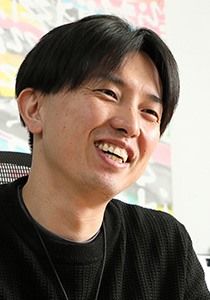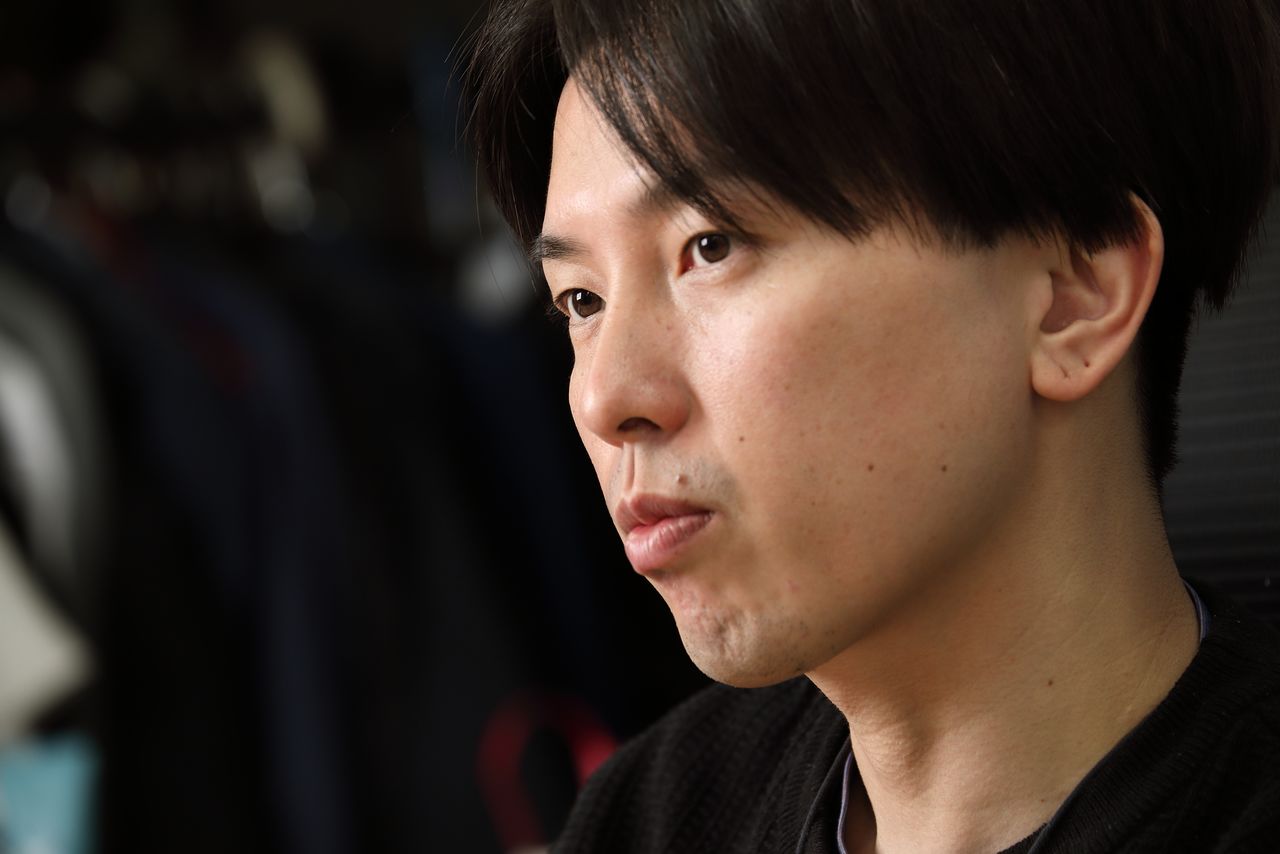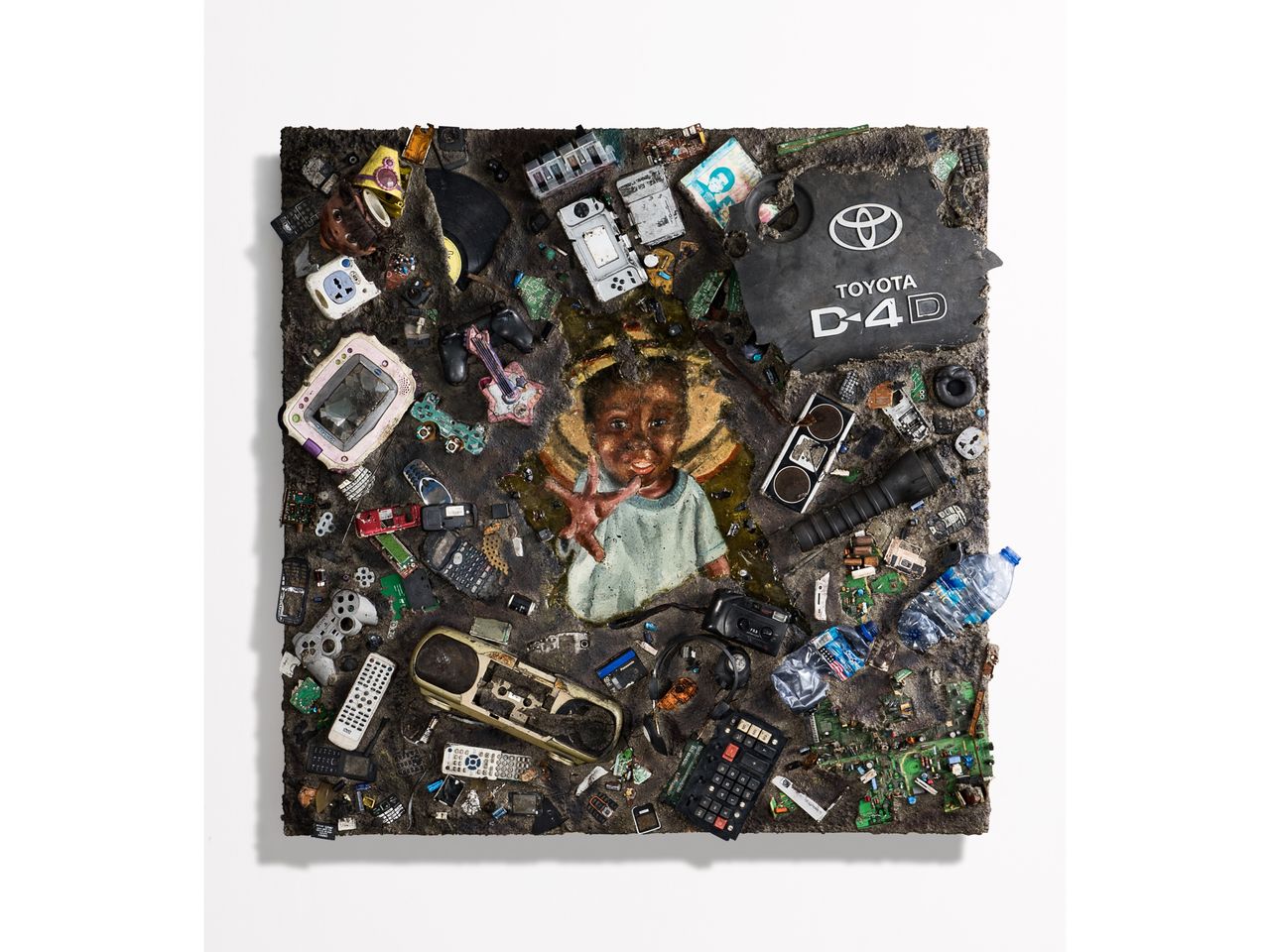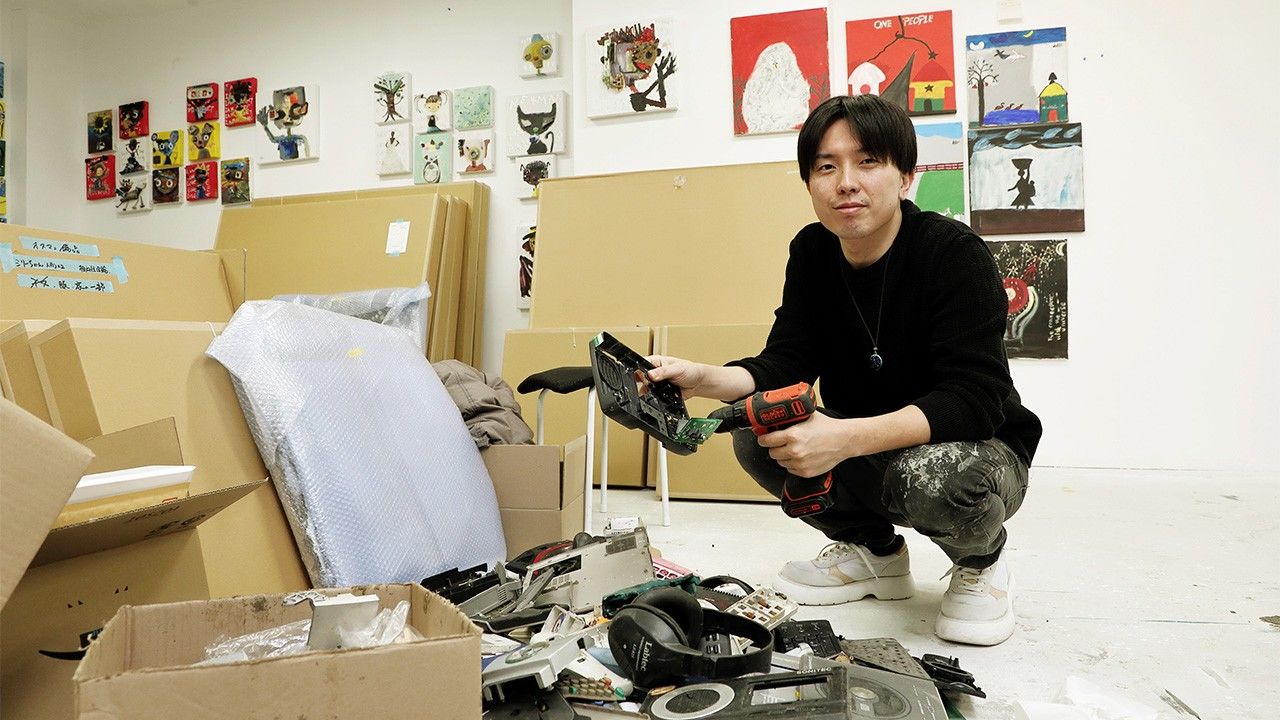
Nagasaka Mago: “Hacking” Capitalism and Making Art from the World’s Biggest E-Waste Dump
People Arts Culture Economy Environment- English
- 日本語
- 简体字
- 繁體字
- Français
- Español
- العربية
- Русский
Returning Profits to Ghana
When Nagasaka Mago calls for “sustainable capitalism,” he does not mean a continuation of the model that has powered the world economy until now. Quite the opposite. While making use of capitalism, which has promoted mass production and mass consumption, he aims to “hack” it and fix the disasters of pollution and poverty that the existing model has created.
“For me,” he says, “sustainable capitalism means getting rid of this obsession with growth, and building a well-balanced circular economy, where economic and cultural development complement and reinforce each other. I want to get more people to understand this idea. If we act together, as well as improving the natural environment before it’s too late, we can resolve a lot of the other problems we face, including disregard for human rights and vast disparities in wealth and opportunity.”
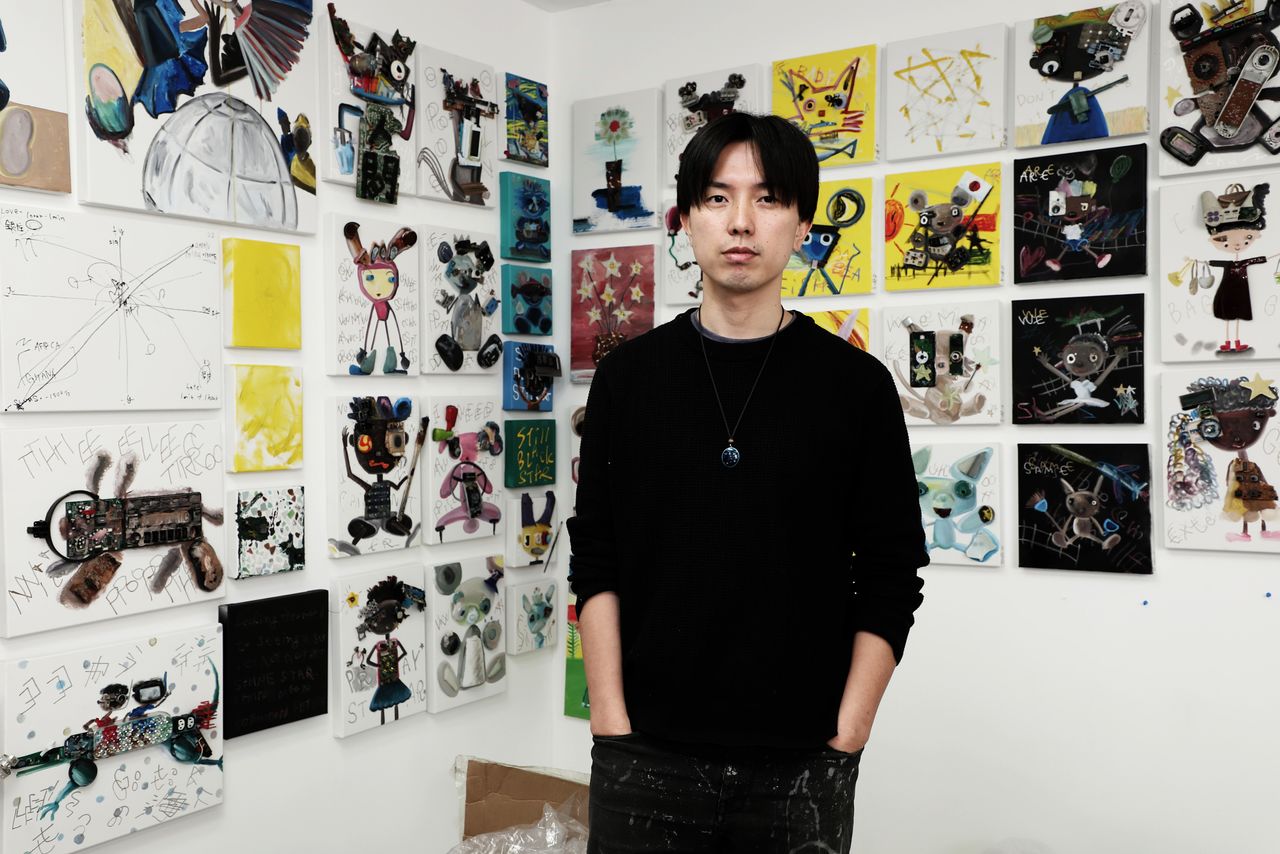
Nagasaka in his studio in the Nihonbashi area of Tokyo. (© Hanai Tomoko)
In 2022, Nagasaka completed 1,000 pictures, sales of which raised some ¥800 million. One large artwork sold for ¥200 million. He keeps 5% of revenue as his own salary, along with further deductions for taxes and running costs. Everything else goes into environmental projects in Agbogbloshie, a shantytown area of Accra, the capital of Ghana.
Already, Nagasaka has built a small recycling plant in Ghana that can handle toxic e-waste, and purchased agricultural land where farmers grow carbon dioxide–absorbing crops like olives and coffee as well as the nutritionally rich “superfood” moringa. For Nagasaka, though, the journey toward his ultimate aim has only just begun.
Creating 30,000 Jobs
“Ultimately, my dream is to build a smart city—a place where the 30,000 people who subsist in the slum today can feel proud and live full and satisfying lives without wrecking their health. The first stage toward accomplishing that goal is creating businesses that can provide jobs.” Nagasaka plans to expand the current recycling plant and agriculture projects, and in the future has dreams of building a factory to produce electric scooters and motorbikes.
“We have good relationships with the University of Ghana, one of the leading centers of futher education in the region, so finding skilled engineers wouldn’t be a problem. At the moment we’re working on a joint project to research a new technology that would make used clothes biodegradable and make it possible to return discarded clothing to the soil.”
Ghana has become a global-scale digital dumping ground, one of the major destinations for externally generated electronic scrap from rich countries. But it’s not only superannuated computers, fridges, and cell phones that end up here. Every week, some 15 million pieces of used clothing arrive from countries around the world, much of it supposedly given away for “recycling” or as “donations.” Around 40% of this refuse is dumped illegally into the sea around Accra. Chemical fibers and plastic parts like buttons and zipper attachments have led to serious marine pollution. Nagasaka’s art is not only made from electronic waste—he also works with discarded apparel and bits of unwanted old clothes.
Nagasaka wondered if it might be possible to return some of this waste to the earth, and started a research project with the local university, mixing pulverized fibers with cow dung, wood debris, and other materials to produce quality soil.
“It’s difficult to find the right proportions for the preparation. If we succeed, we’ll be able to use the soil on our own farms, which would also help as a stepping stone toward building a framework for a better global economy built around recycling and recirculation.”
From Street Artist to Environmental Campaigner
What drove Nagasaka to become so passionate about environmental problems in the slums of Accra?
“Until about five years ago,” he explains, “I was a street artist. I was lucky if I scraped a million yen a year. I never paid any taxes or pension contributions. I was basically a drop-out from society. Then in 2017 I visited Agbogbloshie, and it changed my life.”
As a child, Nagasaka was something of a loner, who liked to spend his time copying pictures of animals and plants from encyclopedias. After high school, he went on to study at Bunka Fashion College, where his talents blossomed and he regularly finished first in fashion contests—with the exception of the graduation contest, when he had to make do with second place. Unfortunately, this meant that he missed out on a scholarship to go and study in England.
Desperate to study overseas, Nagasaka begged his mother to help out. “I know I have talent. Please: let me go and complete my studies abroad!” But his mother wasn’t swayed. “The only thing you’ve learned as a student is how to put on airs,” she said. “You’re too full of yourself!”
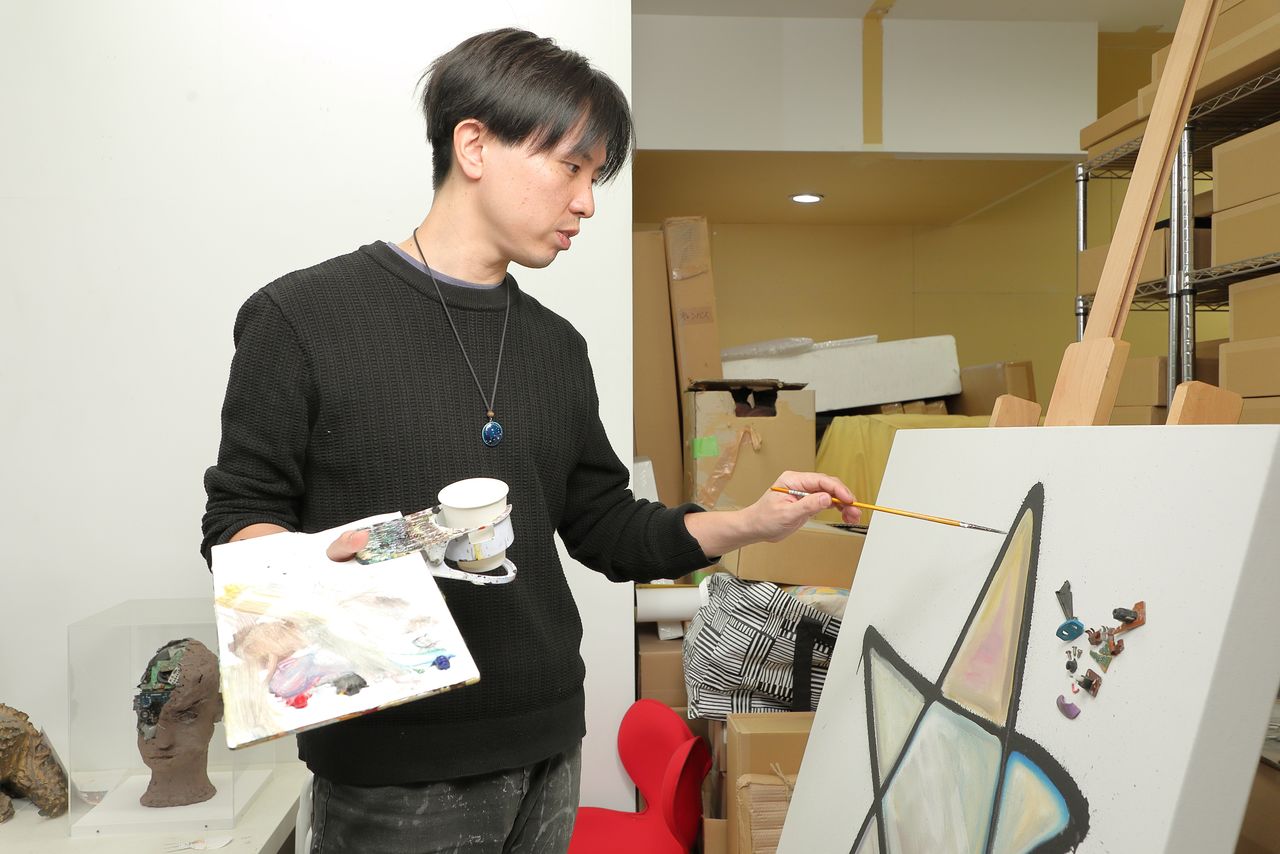
Nagasaka becomes totally absorbed in his work when he’s painting. (© Hanai Tomoko)
To raise funds as quickly as possible, he took a job as a male “host” at a club in Kabukichō, a notorious red-light district in Shinjuku. At first, he lacked confidence and was uncertain how to interact with the female clientele, but eight months later, he was the number one host in the club. Despite his success, he quit just a year later, disillusioned with an empty way of life that brought in money but seemed to offer no purpose or future. With some ¥30 million in savings, he launched his own fashion brand. His experience as a nightclub host had convinced him that he was destined for success as an entrepreneur with his own label.
But he did not know the first thing about business, and within a year he had run through his savings and exhausted his capital. “This is what it means when they talk about money melting away, I thought, as I stared at the mountains of unsold stock in total despair.”
Having lost everything, he became a street artist—one of the few options open to him that didn’t require any seed money. He traveled the country with his painting supplies, living out of an old used car, but his pictures failed to sell. He decided he needed to improve his skills as an artist, and in 2012 set out for New York, at the age of 27.
“I spent eighteen months in New York, working as a street artist. In that time, I took my work to about 500 galleries, but none of them would even look at my stuff. It was a crushing experience.”
After returning to Japan for a time, he set off again, this time for France. By now, he was 30. Basing himself in Paris, he traveled around Europe. As he made a meager living painting shop signs and doing other odd jobs for small change or in exchange for food or beer, he became only too aware of the grim underbelly of modern capitalism. You only had to step away from the glamorous main streets of these glittering cities, he now realized, to find people desperately hunting through trashcans for scraps. Along with the pictures of beautiful women he thought of as a specialty, he started creating works that expressed his hopes for peace. Then, in November 2015, Paris was rocked by the coordinated terrorist attacks at Bataclan and other parts of the city.
“The whole city was afraid. In that tense atmosphere, I realized that the pictures I had made until then meant nothing. They didn’t serve any purpose for people or society at all. I lost my appetite for painting. None of it seemed to make any sense anymore.”
The Dark Side of Consumer Capitalism
Shortly after returning to Japan, he was flicking through a magazine one day when he came across a photo that stopped him in his tracks. It was a picture of Smoky Mountain, a famous slum and rubbish dump in the Philippines, where people pick out a precarious living from smoldering piles of trash. He couldn’t shake off the feeling he had gotten from the image. Resolving to find out more about the problem, he was astonished to learn of a slum and refuse tip in Ghana called Agbogbloshie. Every year, he read, 250,000 tons of electronic waste was brought there from around the world, and the dump and its slums covered an area nearly 150 hectares in size.
In June 2017, he made up his mind to visit the area and see for himself. The reality was worse than anything he could have imagined. A river, black as soot. The sky blotted out by thick clouds of acrid black smoke. The smells of burning plastic and rubber mixed with animal dung and rotting food waste, producing a suffocating, dizzying stench that made it difficult to breathe. As Nagasaka walked around the area in the gasmask he had brought from Japan, the “scavengers” at work on the piles of scrap glared at him and shouted at him accusingly: “What have you come here for?”
Nagasaka says he feared for his life. The experience shook him and opened his eyes to the self-indulgent, unfocused life he had been living. He resolved to visit the site again the next day, and again the day after that.

People burning electronic waste to salvage reusable metal. Thousands of people make a living here by selling scrap salvaged from the dump. (© Mago Creation)
He began to talk with the men working on the dump, who gradually relaxed as they got used to his presence. He came to understand a little of the reality of this “electronics graveyard.” The clouds of noxious smoke that billow from the fires are full of lethal toxins: lead, mercury, arsenic, cadmium, and PCB, to name only a few. Breathing in this toxic cocktail day after day means that many of the men who work here are stricken by serious illnesses by their mid-thirties. In exchange for this physically crippling work, they might earn the equivalent of ¥500 for a 12-hour day, if they’re lucky.
The ground around the dump was covered in a dispiriting tangle of discarded electronic waste: refrigerators, microwave ovens, circuit boards, keyboards, game consoles, smartphones . . . Taking a closer look, Nagasaka noticed that many of the items in the piles of metal and plastic were proudly stamped: “Made in Japan.” The sight, says Nagasaka, made him feel ashamed. “I couldn’t bear it. It made me want to throttle myself.”
“When I was a street artist, I used to pick up smartphones and tablets, or sometimes brandname goods, in America or France, and resell them at a profit in Japan. And now I realized that I had been making a living out of these things that were ultimately costing people their lives. I couldn’t get the thought out of my mind.”
Nagasaka’s visit to Agbogbloshie brought home to him the truth about the dark side of capitalism. He thought he had seen the inequalities brought about by mass-production consumer capitalist societies already, when he had stumbled down back alleys off the glamorous main streets of big cities in wealthy nations. But this went far beyond that. He could not ignore the truth he was seeing now. The comfortable lives of people in prosperous, advanced economies were built on the back of the sacrifices of people like the ones he had met in Agbogbloshie, scavenging for scraps amid a toxic inferno of industrial waste and discarded consumer junk.
After a week in Agbogbloshie, Nagasaka made a promise to the people he had met there. He would take some of the e-waste back with him to Japan and make art out of it. He would do his best to make more people aware of the truth about Agbogbloshie, and if he managed to sell his art he would use the money to build a recycling factory in the community. He now says he marks the beginning of his life’s mission from that moment.
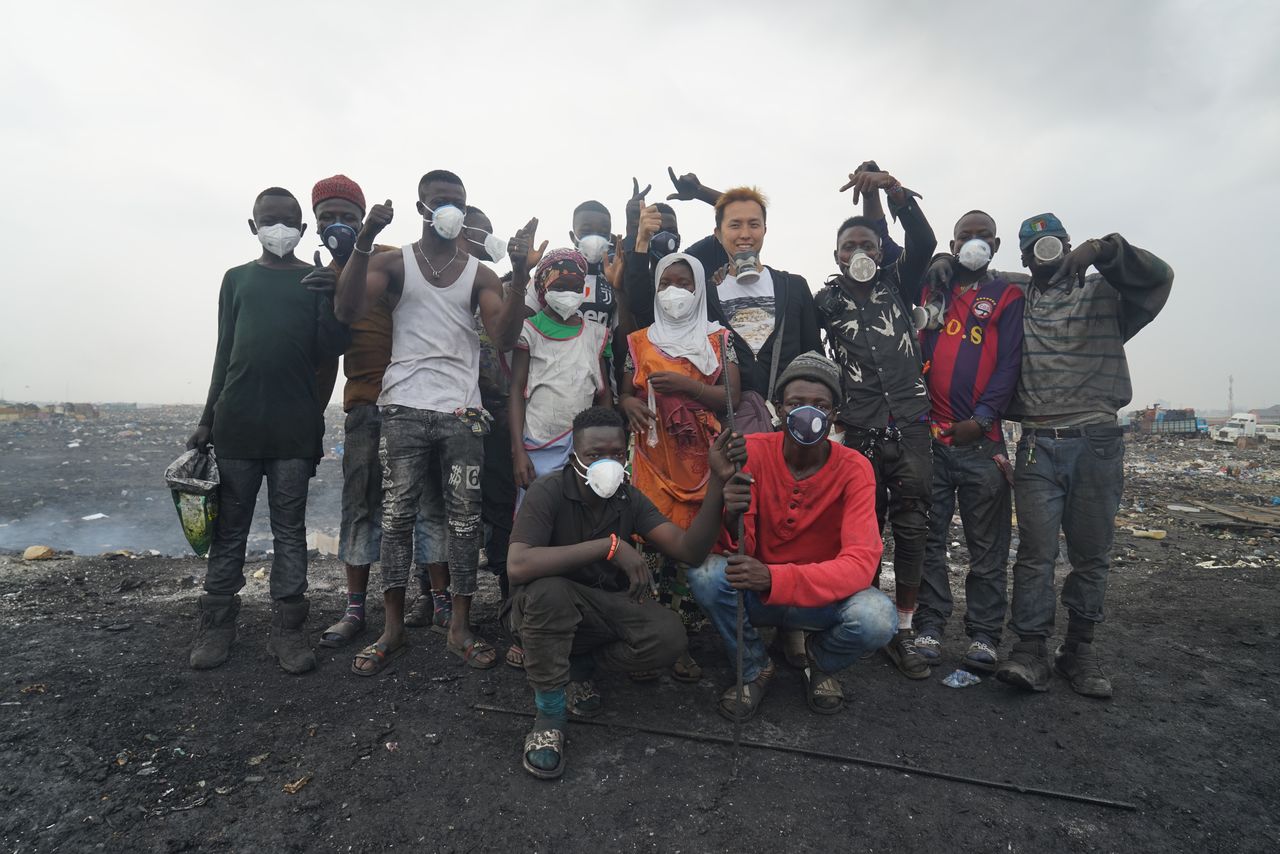
Nagasaka used some of the proceeds from the sales of his work to buy protective gasmasks for the men who work on the dump. (© Mago Creation)
Artworks Worth Millions
In March 2018, a piece of Nagasaka’s e-waste art with the title Ghana’s Son sold for ¥15 million at an exhibition dedicated to his work at a gallery in Ginza, Tokyo. How did an artwork made from reused industrial waste attract such a high price? Nagasaka believes it is the result of “inverting” the exploitation of places like Agbogbloshie by people in the rich world.
“Their poverty is the flip side of the prosperity of people in rich countries. It’s like two sides of the same coin. That’s what gives the pieces their power and meaning. If I made the same works from electronic components I’d sourced in Akihabara, they probably wouldn’t be worth anything at all.”
As Nagasaka started to make a reputation for his unusual art, executives at companies sensitive to the changing climate of the times became interested in his work as a tangible symbol of the efforts they were making toward sustainable development goals. His pieces began to sell for prices in the millions or tens of millions of yen. On occasion, a single work has sold for hundreds of millions. His exhibition schedule is fixed three years into the future.
“Until just a few years ago, I was on the bottom of society, just about scraping by. That I’ve gone from that to become someone now who’s making billions of yen a year from selling my art . . . it’s all leveraged on the sacrifices of the people in the slums. It’s only natural that I put the money back into projects to improve their environment. It’s the least I can do. My hope is that the income from my pictures will help to drive the economy, and that that will develop a culture that enriches people’s spirits and resolves some of the problems we face—not only the environment, but also problems with human relationships and the places where people work. At the root of everything I do is the idea of sustainable capitalism—a new model where there’s a better balance among the economy, culture, and environment. A circular economy where all these elements are balanced and reinforce one another. I want to help reduce the gulf that exits between rich countries and the developing world.”
Ideally, Nagasaka says, the day will come when he will no longer be able to create these artworks that encapsulate the darkness at the heart of capitalism. The true value of his art would be for the materials he uses in them to become no longer available. For now, he continues to draw on a global canvas, sharing with the world his inspirational vision of a better future for all human beings, wherever they happen to have been born.
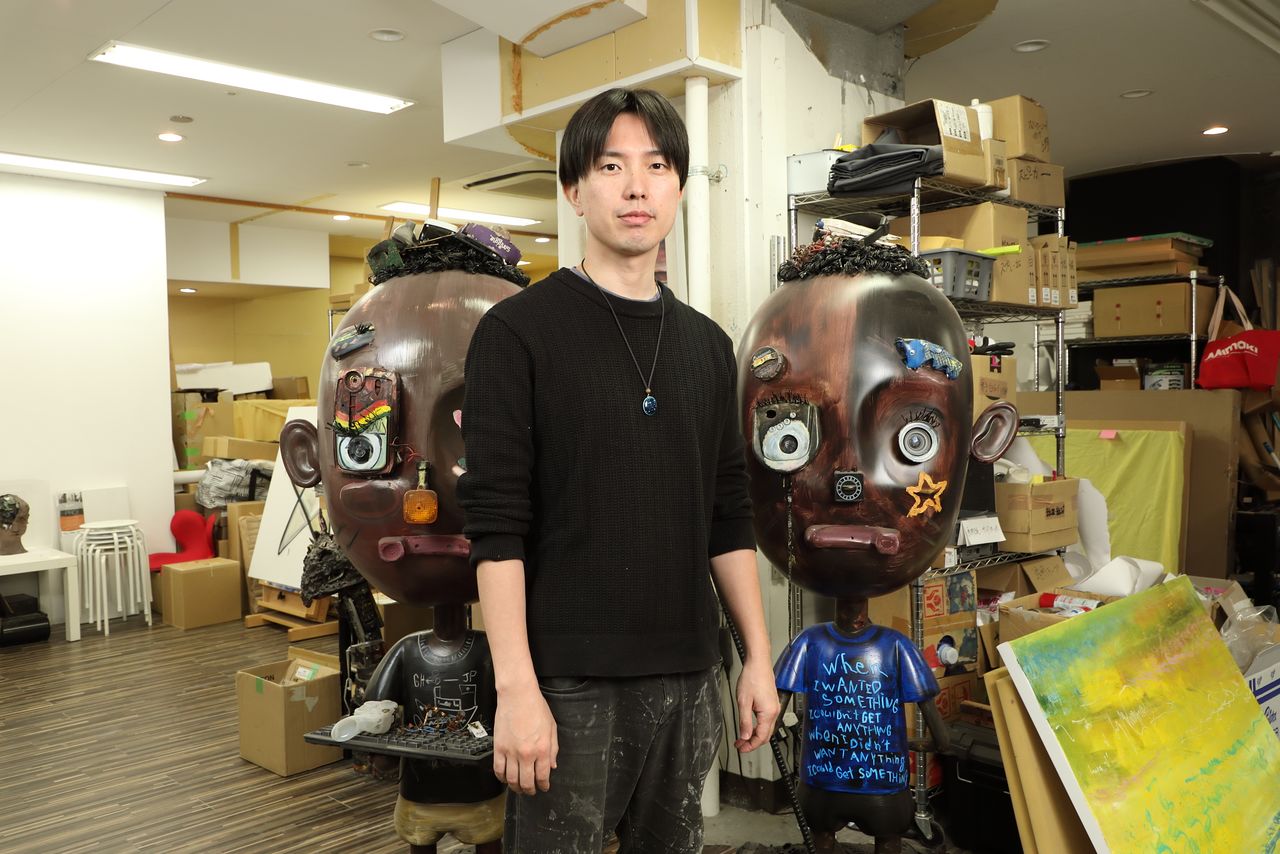
Posing with sculptures made from materials salvaged from the Agbogbloshie dump. (© Hanai Tomoko)
(Originally published in Japanese on January 31, 2023. Banner photo: Nagasaka Mago works with e-waste brought from the Agbogbloshie dump in Ghana. © Hanai Tomoko .)
